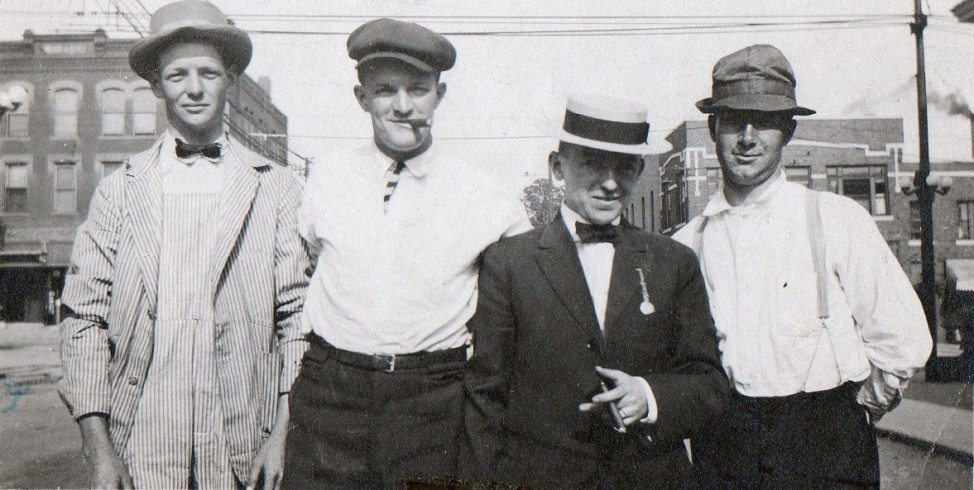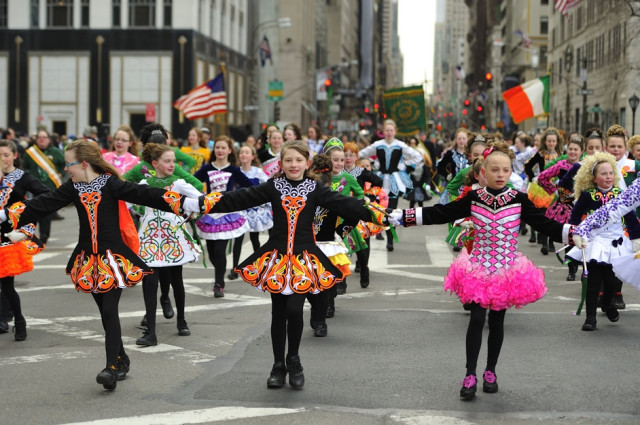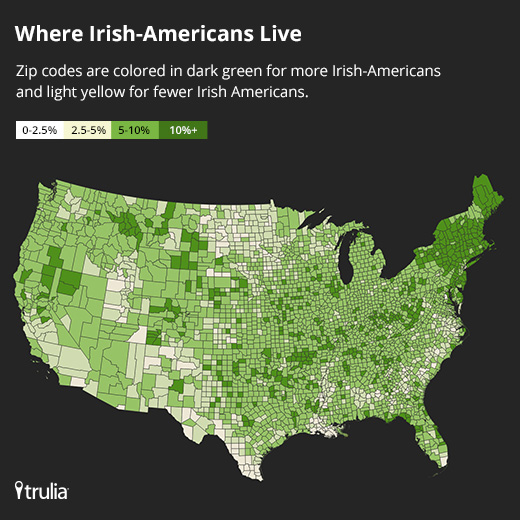
Irish immigrants in Kansas City, Missouri, circa 1909 (Public Domain Photo)
The Irish were among the United States’s first great wave of immigrants in the late 1800s and early 1900s. These newcomers lived in extreme poverty at the lowest rungs of American society, often enduring fervent anti-immigrant and anti-Catholic discrimination.

Young dancers participate in the 2014 St. Patrick’s Day Parade in New York City. (Photo by Flickr user Diana Robinson via Creative Commons license)
Today, more than 33 million Americans proudly claim to have at least some Irish ancestry. People of Irish heritage are so deeply entrenched in America that about half of all the U.S. presidents had some Irish ancestral origins.
The Irish influence in America is so keen that March has been designated as Irish-American Heritage Month and millions of Americans happily celebrate St. Patrick’s Day every March 17.
About 4.5 million Irish people arrived in the United States between 1820 and 1930, according to the Library of Congress.
By 1850, the Irish were the nation’s largest immigrant group, settling primarily on the East Coast and in Southern states. Today, more than 1 in 10 Americans claims Irish ancestry, far more than the experts who keep track of these things predicted.
For example, during the 1980 U.S. Census — the first to contain subjective questions about ethnic identity — far more Americans than could be explained by immigration and birth patterns claimed Irish heritage.
“In 1980, there should have been about 20 million descendants of these Irish immigrants in the United States and then they looked at the data from the 1980 census that first asked about ancestry and it turned out there were 40 million people claiming some Irish ancestry in the census,” said Stephen Trejo, an economist at the University of Texas at Austin. “People of multiple backgrounds tended to report Irish more than other things maybe because it was more fun with St. Patrick’s day or for other reasons, they felt more attached to that, so they reported that.”
 A 1994 paper in the American Sociological Review concluded, “an unexplained subjective “closeness” to Ireland contributed to the size of the Irish American population in 1980.”
A 1994 paper in the American Sociological Review concluded, “an unexplained subjective “closeness” to Ireland contributed to the size of the Irish American population in 1980.”
Today’s Irish Americans are faring far better than the earliest Irish arrivals.
The median income for households headed by an Irish American is $62,141, higher than the median household income of $53,657 for all U.S. households, according to the U.S. Census Bureau. Forty-two percent of Irish Americans work in management, business, science and arts occupations, 24 percent are in sales or office occupations, while 15 percent are in service occupations.
Today, 10 percent of Americans claim some Irish heritage, but there’s a saying in the United States that, on St. Patrick’s Day, everyone is Irish.
On March 17, many Americans will happily drink to that.
More About America:
Most US Wealth Is Concentrated in These 10 Areas
Poll Finds Young Americans Are ‘Frightening’ Liberal
Who’s Losing Out on the American Dream?
Rare 1903 Footage Captures Busy Boston Streets
How Diversity Has Changed America






















How the discrimination of minorities ended without the “affirmative actions”? The WASPS kingdom have disappeared by hard work,successful competitions and the respect won as a result. That was with the Irish,Italians,Jews. There were no revolutions, “Irish power”,”Jewish lives matter”, just theirs legal defence of theirs right. The same way is the just possible way for blacks.
Bit sad really… could do better.
A pleasant surprise VOA, thank you. I am Irish and American and hold passports from both countries and was born in the US. I am also a Catholic, a practicing Catholic.
My Grandfather and then later my Mother and Grandmother immigrated to the US during the Anglo-Irish War in the early 1920’s.
My Grandmother never recovered from her hatred of Britain from a beating she received one night from three Black and Tans who broke into her home in the west of Ireland looking for an IRA relative.
My Mother was just a toddler at the time and she was beating the Tan who was beating her mother with a broom.
When my Grandmother refused to tell the Tans the whereabouts of her IRA relative they went outside her home and threw burning torches on the thatched roof. But her home was saved since it had rained earlier that night and the thatch was wet.
While Bridget was shaken from what the Tans did to her she never stopped loving her Ireland and her Catholic Faith and it was from her that I learned to appreciate my Irish Heritage and my Catholic Faith.
My Grandmother repeatedly spoke of the 6 counties and the importance of their being returned to Ireland.
When NORAID came to town my grandmother told me she “Gave a fat check to the boys back in Ireland.”
In 1970 when I returned back from South Vietnam I made it a point take my Grandmother Bridget out to dinner.
In 1967 I made one of the best decisions in my life. I dropped out of the University of Florida and enlisted in the US Marine Corps in Gainesville, Florida.
The Marine Corps had an Enlisted Commissioning Program and from that I was commissioned in 1968. Like all newly commissioned second lieutenants I was sent to The Basic School, also in Quantico, Virginia to be trained as infantry platoon commanders.
The professionalism and the dedication of the Marine NCO’s at OCS and the Marine officers at TBS that trained us was outstanding and nothing I have seen since.
I have worked for Fortune 500 companies, but even upper management at these companies did not approach the dedication and professionalism of the Marine NCO’s and officers that prepared us for the war in Vietnam.
I was later sent to the US Army’s artillery school at Ft. Sill and it was in Vietnam that I gained a deep appreciation for the training that I received at TBS.
But the story of Irish Americans goes deeper than just another ethnic group that landed on America’s shores because recently just last year was published “How the Irish Won The American Revolution, A New Look at the Forgotten Heroes of America’s War of Independence.”
The author Phillip Thomas Tucker fittingly starts his book with Chapter 1 with a statement from a British officer “You Have Lost America by the Irish”.
Tucker does distinguish in his book the Irish Catholic from the Scotch-Irish Presbyterians.
Tucker on pages 11-12 describes George Washington correctly prophesying in a letter how future historians would not understand and explain how a military force from the British Empire that fought for 8 years in America could not defeat America’s Revolutionary Army that was less in numbers than the British Army. A Revolutionary Army that were half starved, always in rags, without pay and experiencing every distress that human nature undergoes.
However Washington then said he now understood the importance of the Irish and Scotch-Irish contributions to the winning of America’s independence and then stated:
“Ireland was thou friend of my country in my country’s most friendless day.”
In the above VOA article is “A 1994 paper in the American Sociological Review concluded, “an unexplained subjective “closeness” to Ireland contributed to the size of the Irish American population in 1980.”
But in a New York City newspaper that was published in 1852 was a grim warning to the British Empire about the recent Irish immigrants to America driven from their homes by what Tim Pat Coogan calls “The Famine Plot.”
“driven from their homes by English misrule the Irish in this country will always cherish towards England feelings of intense hatred………..If the day of England’s should every come……..her fiercest foes would be those of Ireland……..Fiercest in every fight would be those who have been crushed and starved, and finally driven across three thousands miles of sea. Ireland will one day be the Nemesis of Great Britain.”
This grim prophecy was fulfilled when a New York born Irish-American with a Spanish father and a Irish Mother Eamon de Valera returned to Ireland as a young child, then in the IRA and at the 1916 Easter Uprising and later in a British prison devoted his life to severing Ireland from the British Empire forever when Ireland became a republic in 1949.
But yes My People were once scorned, as I was once in high school 55 years ago with an anti-Irish slur heard by all within hearing distance.
But to date while two of Leon Uris’s novels, “Battle Cry” and “Exodus” have been made into movies, but not his “Trinity” a novel of Ireland that was published 40 years ago. Leon Uris’s Trinity was wrote of the period of Ireland’s The Great Hunger to the Easter Rising of 1916.
The only time I hurt my Irish Grandmother Bridget was when I learned of Ireland’s Great Hunger and in a college class and asked her about it.
She became very angry at me shouting that Ireland always had food and nobody in Ireland starved to death. My Grandmother was born in 1897 in a small Irish village and thus lived through the 1916 Easter Uprising. But the oral history of Ireland’s The Great Hunger she learned from her parents and it hurt her badly.
Whenever topic of the Easter Uprising came up she would tell me holding her Rosary that she didn’t know why the British Empire executed the Irishmen who were fighting for Ireland’s freedom. She was emotional about it and close to tears.
Of course the last thing the heart of the British Empire needed was an Irish Republic on its doorstep. Bridget passed away at 95 and she would time to time when we got together speak of the 6 counties in Ireland’s north. I am now 73 and I hope to see my Ireland one country again.